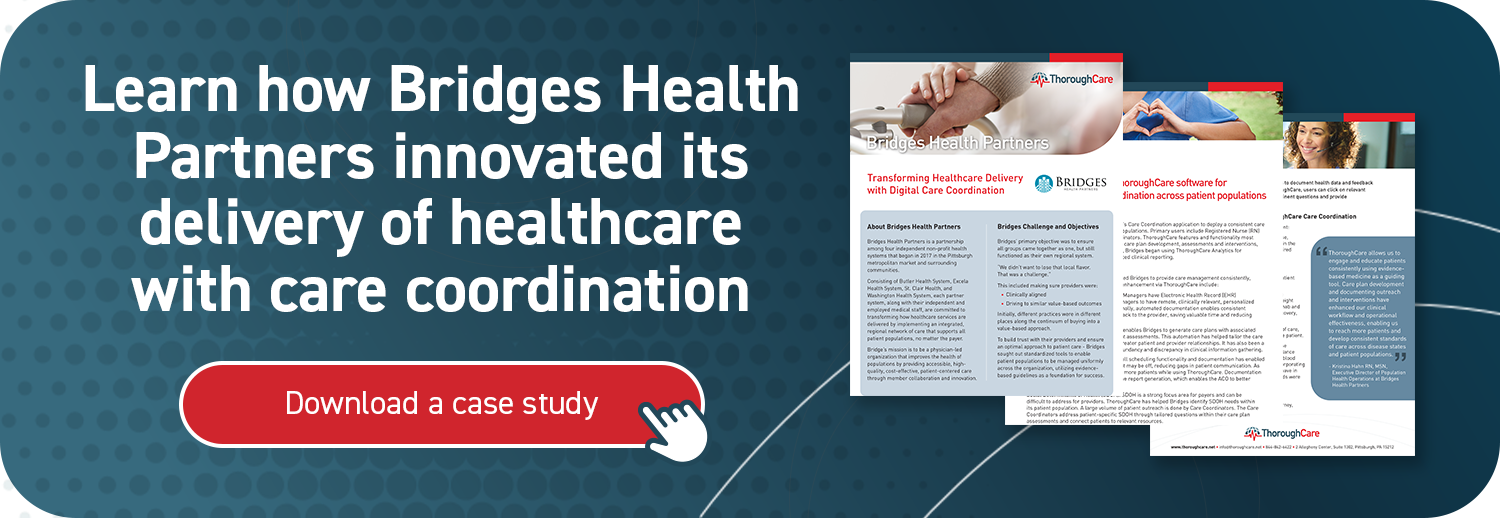ThoroughCare Analytics | Value-Based Care | Health Plans
Why Care Gaps Matter to Health Plans and Providers
Quality is a foundational tenet of the US healthcare system. Performance measurement provides a standardized approach to prioritize specific clinical or operational outcomes.
For example, managing chronic illness through care management and value-based care models has put a greater emphasis on preventive medical care. That’s where care gaps play their role.
Care gaps reveal the delta between a health plan’s or provider’s performance and the established ideal or standard.
HEDIS, Star Ratings, and Care Quality Measurement
In the US, the following are the most widely used quality performance measures:
- Star Rating created by the Centers for Medicare & Medicaid Services (CMS)
- HEDIS: Healthcare Effectiveness Data and Information Set
- CAHPS: Consumer Assessment of Healthcare Providers and Systems
- HOS: Health Outcomes Survey
- PDE: Prescription Drug Event
Star Ratings cover most types of healthcare organizations—from hospitals, health plans, nursing homes, and home health agencies—and utilize the four other measurements as part of its overall five-star rating system.
HEDIS, however, is one of the most widely used performance measures and improvement tools. More than 200 million people are enrolled in health plans that report HEDIS results.
CMS contracts with the National Committee for Quality Assurance (NCQA) to collect and maintain HEDIS measures. The purpose of HEDIS measures is to demonstrate how well a health plan carries out preventive care and chronic disease management.
Why HEDIS is important to health plans and providers
HEDIS is essential for providers as they comply with health plans to help close care gaps, ensure effective care per their contracts, and support revenue through pay-for-performance and value-based or accountable care programs.
A provider engaged in a value-based arrangement typically negotiates their contract with a health plan. This includes determining HEDIS measures with target performance metrics.
Once agreed upon, the provider organization must annually report its performance related to patient outcomes. A health plan can then optimize its shared savings if targets are met.
HEDIS guidelines are updated each year. As of 2023, there are more than 90 key performance metrics across HEDIS’s six domains of care.
Examples of HEDIS measures focused on prevention include screenings for lead in children, breast cancer for women starting at 40 years of age, and colorectal cancer for adults 50-75.
In addition to regular screenings, they provide health targets like those for comprehensive diabetes care, including:
- Hemoglobin A1c testing (HbA1c poor control >9, HbA1c control <8)
- Blood pressure control (<140/90 mmHg)
- Retinal eye exam
- Medical attention for nephropathy
Care gaps decrease HEDIS scores
Gaps in care lower a health plan’s HEDIS score, and improving the frequency of prioritized preventative screenings will enhance a HEDIS score. But why are HEDIS measurements important to both health plans and providers?
Not only is HEDIS a component of CMS Star ratings, but it is critical as a standalone set of measures. HEDIS is used to qualify for reimbursement, receive bonus payments, and participate fully in value-based contracts.
It’s estimated that a health plan with 100,000 members would qualify for $17 million in reimbursement for each quality measure taken.
Working together to close care gaps is vital to improving quality measures
Research shows that care gaps are harmful to member health and costly if not managed properly. Mismanaging chronic diseases, such as diabetes, can lead to severe complications, escalating treatment costs, and lower HEDIS scores.
Collaboration between health plans and providers is key to achieving higher quality performance scores. This is particularly true for HEDIS as the data needed to complete analysis relies on claims but also information directly submitted by providers.
And, because HEDIS focuses on prevention and wellness, it’s imperative that the member, health plan, and physician communicate and coordinate based on trustful data sharing. Working together to close care gaps benefits everyone.
Suppose a member doesn’t receive certain preventive services or screenings—based on age, gender, or health status—that creates a care gap. As care gaps accumulate within a member population, the desired level of care quality declines, which is reflected in the HEDIS score.
How chronic care management can close care gaps
A Chronic Care Management (CCM) program can help ensure that a provider organization is doing its part to attain quality standards.
When a CCM program is organized, tech-enabled, and streamlined, it provides an effective opportunity to resolve care gaps. Here are five ways a CCM program can supplement or support HEDIS measures by preventing and addressing prioritized care needs for members.
Provide cyclical consistency
Care gaps can emerge and change over the year as members receive care throughout their network of providers. CCM enables a structured and regular touch point where preventive health needs can be addressed. It’s important to find a balance that allows timely intervention with staffing resources.
Integrating with workflow
A successful chronic care management program provides a structure that integrates into clinical and operational workflows. Closing care gaps require the same diligence. CCM technologies can facilitate identifying, capturing, and resolving care gaps.
Similar to CCM, closing care gaps for HEDIS measures entails following a standard of care, creating a goal, and an action plan. CCM takes it a step further because the member can receive interpersonal support to take action toward care gap resolution.
Monthly gap analysis and reporting
Again, the cyclical nature of CCM lends itself to establishing a monthly routine for care gap data reporting. Many health plans report on the number of care gaps identified, outstanding, and closed. Providers can do the same for their patient cohort and share their progress.
Additionally, through CCM data analysis, care managers can compare data sources to uncover and validate gaps. They can cross-reference care gaps with upcoming appointments, or they can use the next CCM call to review the value of prevention and outstanding screenings.
Maximize data sources
CCM program data can be useful input for HEDIS quality measures and care gap closure. Whether through a data feed or manual data entry, care management information provides another source beyond submitted claims and EMR data.
Seasoned provider teams can use past activity to predict where likely gaps could arise in the upcoming year. In this case, CCM can help plan for necessary screening and prevention activities.
Aligning care priorities
Typically, the U.S. Preventive Service Task Force develops recommendations, and organizations, such as the NCQA, develop their quality metrics from those recommendations. In this case, NCQA updates HEDIS based on any priority shifts. Changes to existing measures come down to health plans and their provider constituents.
Beyond HEDIS measures, health plans may add quality measures for a particular member population or VBC program.
Health plans emphasize measures related to specific incentives, those that are triple-weighted by CMS’s Stars score matrix, and those that are common to multiple contracts. Health plans also develop measure-specific rewards in areas where they have been historically weak.
How ThoroughCare helps identify and resolve care gaps
ThoroughCare can help health plans and providers track and report quality performance metrics across patient populations. With data analytics dashboards, healthcare organizations can:
- Monitor key performance metrics to spot gaps in care
- Interpret patient data as health trends take shape
- Close workflow gaps to further reduce cost
ThoroughCare enables decision-makers to act on data, align priorities at scale, and automate care plan suggestions to improve outcomes and engagement.


.jpg)

